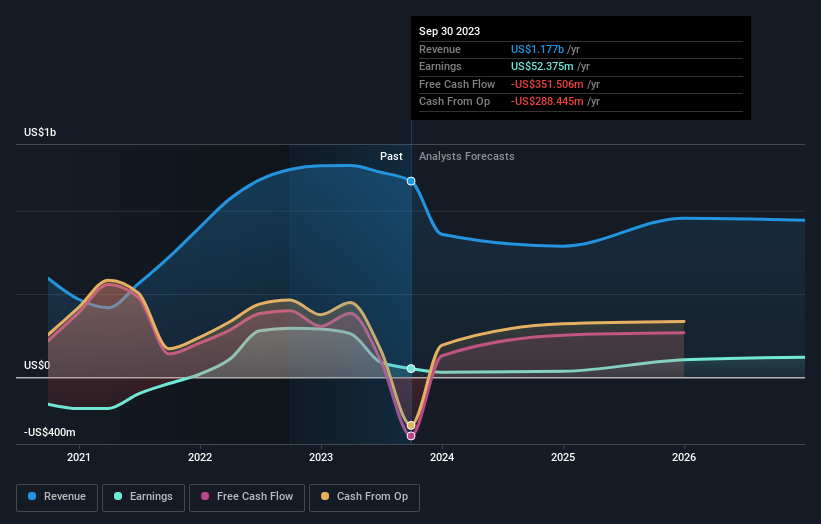Stock Analysis
- United States
- /
- Consumer Finance
- /
- NYSE:LC
LendingClub Corporation (NYSE:LC) institutional owners may be pleased with recent gains after 9.2% loss over the past year

Key Insights
- Institutions' substantial holdings in LendingClub implies that they have significant influence over the company's share price
- The top 14 shareholders own 50% of the company
- Insiders have bought recently
If you want to know who really controls LendingClub Corporation (NYSE:LC), then you'll have to look at the makeup of its share registry. The group holding the most number of shares in the company, around 75% to be precise, is institutions. Put another way, the group faces the maximum upside potential (or downside risk).
After a year of 9.2% losses, last week’s 12% gain would be welcomed by institutional investors as a possible sign that returns might start trending higher.
Let's delve deeper into each type of owner of LendingClub, beginning with the chart below.
See our latest analysis for LendingClub

What Does The Institutional Ownership Tell Us About LendingClub?
Many institutions measure their performance against an index that approximates the local market. So they usually pay more attention to companies that are included in major indices.
As you can see, institutional investors have a fair amount of stake in LendingClub. This implies the analysts working for those institutions have looked at the stock and they like it. But just like anyone else, they could be wrong. If multiple institutions change their view on a stock at the same time, you could see the share price drop fast. It's therefore worth looking at LendingClub's earnings history below. Of course, the future is what really matters.

Since institutional investors own more than half the issued stock, the board will likely have to pay attention to their preferences. We note that hedge funds don't have a meaningful investment in LendingClub. Looking at our data, we can see that the largest shareholder is The Vanguard Group, Inc. with 10.0% of shares outstanding. Meanwhile, the second and third largest shareholders, hold 8.6% and 8.4%, of the shares outstanding, respectively. Additionally, the company's CEO Scott Sanborn directly holds 1.3% of the total shares outstanding.
After doing some more digging, we found that the top 14 have the combined ownership of 50% in the company, suggesting that no single shareholder has significant control over the company.
Researching institutional ownership is a good way to gauge and filter a stock's expected performance. The same can be achieved by studying analyst sentiments. There are a reasonable number of analysts covering the stock, so it might be useful to find out their aggregate view on the future.
Insider Ownership Of LendingClub
The definition of company insiders can be subjective and does vary between jurisdictions. Our data reflects individual insiders, capturing board members at the very least. Company management run the business, but the CEO will answer to the board, even if he or she is a member of it.
I generally consider insider ownership to be a good thing. However, on some occasions it makes it more difficult for other shareholders to hold the board accountable for decisions.
Our most recent data indicates that insiders own some shares in LendingClub Corporation. As individuals, the insiders collectively own US$33m worth of the US$976m company. This shows at least some alignment. You can click here to see if those insiders have been buying or selling.
General Public Ownership
The general public, who are usually individual investors, hold a 22% stake in LendingClub. This size of ownership, while considerable, may not be enough to change company policy if the decision is not in sync with other large shareholders.
Next Steps:
I find it very interesting to look at who exactly owns a company. But to truly gain insight, we need to consider other information, too. Case in point: We've spotted 2 warning signs for LendingClub you should be aware of.
If you would prefer discover what analysts are predicting in terms of future growth, do not miss this free report on analyst forecasts.
NB: Figures in this article are calculated using data from the last twelve months, which refer to the 12-month period ending on the last date of the month the financial statement is dated. This may not be consistent with full year annual report figures.
Valuation is complex, but we're helping make it simple.
Find out whether LendingClub is potentially over or undervalued by checking out our comprehensive analysis, which includes fair value estimates, risks and warnings, dividends, insider transactions and financial health.
View the Free AnalysisHave feedback on this article? Concerned about the content? Get in touch with us directly. Alternatively, email editorial-team (at) simplywallst.com.
This article by Simply Wall St is general in nature. We provide commentary based on historical data and analyst forecasts only using an unbiased methodology and our articles are not intended to be financial advice. It does not constitute a recommendation to buy or sell any stock, and does not take account of your objectives, or your financial situation. We aim to bring you long-term focused analysis driven by fundamental data. Note that our analysis may not factor in the latest price-sensitive company announcements or qualitative material. Simply Wall St has no position in any stocks mentioned.
About NYSE:LC
LendingClub
LendingClub Corporation, operates as a bank holding company, that provides range of financial products and services in the United States.
Excellent balance sheet with moderate growth potential.

